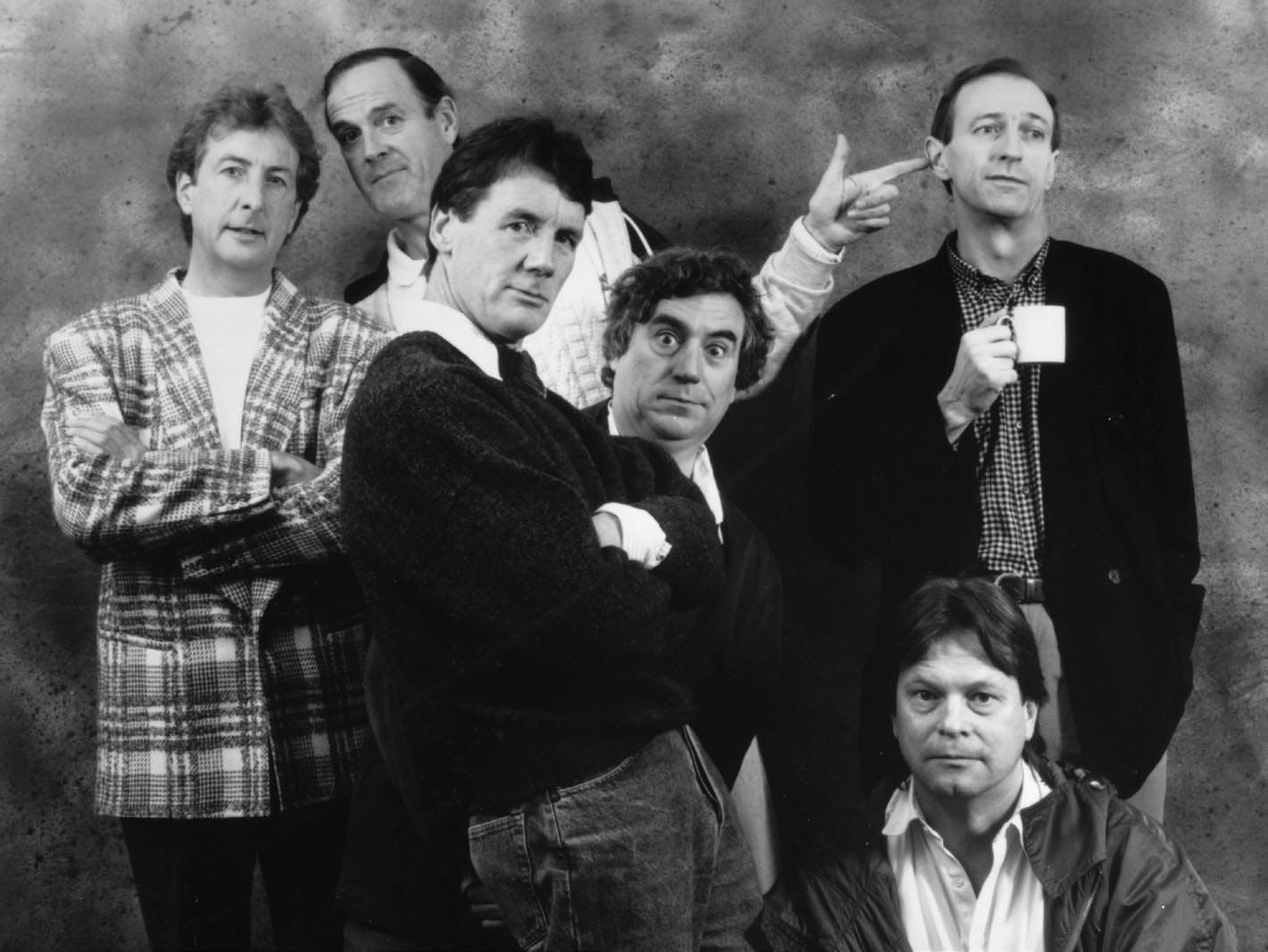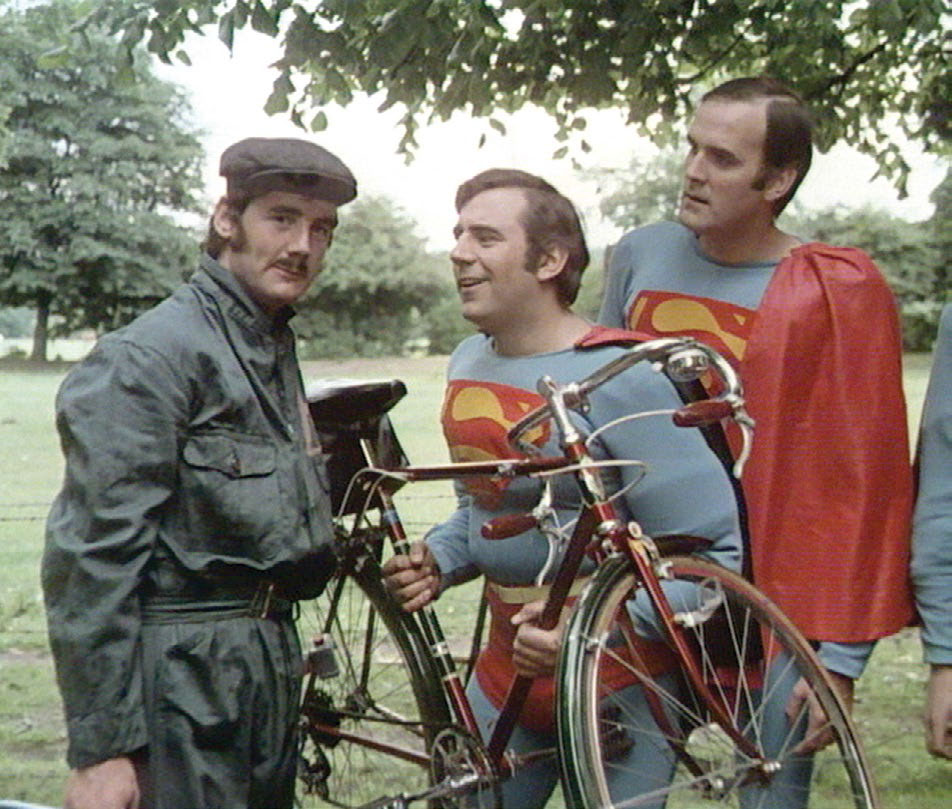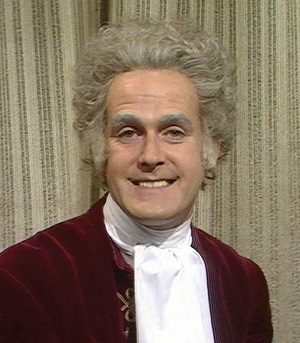Fifty Years of Silliness
LONDON—Half a century ago, Monty Python crashed onto British TV screens like a giant animated foot. To celebrate 50 years since “Flying Circus” took off on BBC1 back in October 1969, the Pythons are launching a selection of items and events including a film season at the BFI, a commemorative “Very Silly” IPA and a world record attempt for the “largest gathering of people dressed as Gumbys.”

Closer to reality, all 45 episodes of “Monty Python’s Flying Circus” will be released on limited-edition Blu-ray and DVD, along with unseen and excised footage. All four series are being painstakingly restored and upscaled to HD by Network Distributing, a complicated process that’s enough to make anyone’s brain hurt.
“I can see why this hasn’t been done before, because it’s a huge task. It’s a real jigsaw puzzle mix of existing material,” explains restoration colorist Jonathan Wood. “You’ve got the original quad tapes; you’ve got 16 millimetre film; you’ve got neg and prints; you’ve got 35 millimeter; you’ve got some bits only available in NTSC; you’ve got some film recording that we’re doing color recovery on. We’ve got everything you can think of. And that’s not unexpected because that is the era of the material. It just means it’s a very complicated puzzle to put together.”
BRING CLARITY TO THE CHAOS
Network’s task involves scanning, transferring and upscaling all this footage, but not before cleaning up the SD material. “Most people have got a flat-screen TV on the wall—it’s either HD, 4K, it’s a big screen,” says Wood. “These programs are made in the era where it’s a 20-inch tube telly in the corner of the room. And the trouble is, if you take those raw tapes and you just upscale them and put them on one of these modern screens, you’re going to see all the faults. You’re going to see all the noise, the dropouts, the flashes, the field phase areas, chroma areas, all sorts of things. And that’s not what it’s about; this is about getting the best presentation of these episodes as possible in a high-definition format.
“When you have dealt with the faults, you’ve got rid of the flashes, the dropout, the dirt, you may have improved the color; what you’re left with is just the performance,” he continues. “The original video tapes and everything else is the carrier. It’s just the medium by which the performance was brought to the viewer. If you can clean that up then that’s what you’re watching. You’ll never be disturbed by, ‘Oh what was that flash there; oh look at the dirt all over that.’” He also notes the “intrinsically SD” nature of videotape, meaning the restored shows will not look as good as the latest 4K blockbusters. “But you can improve it hopefully to a degree where it’s not a shocking contrast. The whole idea of this is to present the episodes in the best quality possible.”
That the complete set of tapes even still exists is “amazing” to Wood, given the BBC’s propensity to reuse tapes in the ’60s and ’70s, let alone the survival of unaired footage originally cut for timing or censorship reasons. “There will be quite a good amount of content that possibly most people are unfamiliar with, which have just been languishing in a can or wherever, unseen until now,” he adds.
Get the TV Tech Newsletter
The professional video industry's #1 source for news, trends and product and tech information. Sign up below.
There are also formatting issues to consider in dealing with film that’s not dead but has been resting for 50 years, as Wood explains: “We’re finding that they sometimes make use of polygon telecine, which was a particular type around in the ’60s and ’70s. And the trouble with that is that often for one reason or another it wasn’t fully frame locked, so you end up then having film frames smeared across different video frames. So in trying to clean up the dirt from that, if you haven’t got the film and you’re having to work from tape, it’s extremely difficult because the dirt then appears on more than one frame. So those sequences are not good to work on. If you get something like that episode, it’s going to take considerably longer to clean up.”
’PILLARBOX HD’
The restoration retains the original broadcast’s 4:3 aspect ratio, in “pillarbox” HD, with black masking on either side. Wood describes looking at previous restorations of the series: “Because you’re dealing with analog recordings, the line length in terms of the width of the picture changes quite considerably, sometimes between episodes, sometimes between scenes. And I think to standardize it previously they zoomed the picture and cropped to what are the standard dimensions. We decided we’re not doing that, we’re just filling the height of the picture so we have a clean top and bottom, but then we’re leaving the width to whatever it is on the original… it was made in 4:3 and stays in 4:3.”
Wood adds that the brief from Python HQ was straightforward in terms of making the episodes as high quality as possible for 21st century viewing. “Terry Gilliam came in the other day and I’m very pleased to say he was very happy with what he was seeing,” he notes.
On the subject of Terry Gilliam, Monty Python’s sound editor of 50 years André Jacquemin is full of praise. “Terry is brilliant to work with,” he says, having worked on a number of the director’s feature films, most recently ‘The Man Who Killed Don Quixote.’ But now Jacquemin is back in Python mode for five new Radio 4 specials, executive produced by Michael Palin and produced by Jacquemin, assisted by James Peak, again featuring unheard material from the Monty Python sound archives.

“We had to dig in and make a choice about what was available, what was left, what was unheard that was never released,” says Jacquemin. “But we thought what we’d like to do is to try and get some alternative versions of the originals, so we found a couple of those and somehow we made up the programs. But it was certainly a bit of a research job to go back into the archive and many hours and hours of listening.
“Then everything was put through with Mike [Palin] and I finished remixing the sketches so it was in some kind of good order and sounding as fresh as the day we originally recorded them,” he continues. “And then once it went through the Mike process, we then emailed everybody in the Pythons and let them hear it and had their suggestions as well, which then had a few tweeks that the other Pythons made. So it’s pretty much a Python project.”
He adds that the material “sounds like it was recorded yesterday—and the other weird thing, which I felt very attached to, was hearing Graham Chapman, and obviously Terry Jones has got a problem now as well, and just hearing how vibrant and how intuitive their performances were, and how brilliant they are; I miss their involvement dearly. And just the sheer quality of the stuff—not just in what they’d had written and performed, but actually in the quality of the recording. So in that sense, I think we did a really, really good job for it to stand the test of time, and actually the quality was there.”
Sound editing has obviously changed considerably since then, and Jacquemin recalls co-writing the “Life of Brian” title music with Dave Howman: “Terry Gilliam said ‘I think it’s a bit long now so we better take a verse out.’ And we recorded the song on a 1-inch 8-track tape machine so we didn’t have any backup. I said to Terry, ‘You sure you want to cut this out? We should really copy the tape and have a backup in case something goes wrong with the razor blade when we slice the tape up.’ And he says ‘Andre I trust you, just hack away.’ So I cut the verse out and luckily it went all right, but had that gone wrong, we could have been in trouble because at least with digital, you can recall your mistakes. And on tape, if you don’t have a copy of something and you crease, damage or the tape gets stretched, you’ve lost it.”
Jacquemin was also keen to involve Gilliam in the radio project, a format incompatible with animation. “I wanted to get him involved in the process of the radio thing and I thought, ‘Well how do we do this?’” he says. “Without giving too many secrets away I managed to get Terry involved in the program, because I thought it’s a very important element, him being the animator more than one of the actors. So I came up with an idea for Terry, which he loved so that worked out really well.
“The thing about working with Terry is you have to get into Terry’s mind and you have to kind of try and stay one step ahead, which is unbelievably difficult,” he continues. “People do say a lot of times, ‘Oh god, it must be chaos working with Terry, blah blah blah. And I actually find him so good, so talented, so original and he’s a pussycat really in a way. And we get on obviously very well having worked together for 50 years now. I truly believe Terry is a genius.”
He says the same of the Pythons as a group: “You have to kind of get into their heads. People say, ‘Oh Andre, you must have had such a whale of a time when you were working with them and it must have been just a barrel of laughs.’ Well actually, it was a barrel of laughs, but it was quite a serious barrel of laughs. We had to concentrate very hard that we didn’t lose pace; everything was a little bit haphazard when we’re working because sometimes if we didn’t like a sketch or there was something we felt needed a little more work while recording, we would then jump to another sketch. But then they would say, ‘Let’s have a go at that other sketch’ and then you’d have to go back to the other sketch. So it’s quite a haphazard way of working and we obviously had to keep a strict list of where things are to be recalled at any moment.”
Jacquemin recalls the last time Monty Python performed live together: “We were in the dressing room and it was just amazing how when they’re together, there’s just something quite electric with them all. The atmosphere goes up about 20 notches, and it gets almost electrical blue because of the energy that’s in the air. It’s quite fascinating just to witness that. And you just realize how clever and how brilliant they are individually, but collectively, they’re an awesome force.”
A 50th anniversary statement from the group themselves reads: “Python has survived because we live in an increasingly Pythonesque world. Extreme silliness seems more relevant now than it ever was.” It’s Jacquemin’s view that a Monty Python political party could be the solution. “They’ve all got their own very, very strong strengths, and I think they would have been a brilliant political party to sort our troubles out.”

Would Minister of Silly Walks John Cleese’s views on Brexit and immigration not cause a People’s Front of Judea style fracture? “Well possibly, but interestingly enough I actually recorded Peter Mandelson’s autobiography, and as he was reading through his book I thought a lot of the stuff that was going on in the background of the Labour Party was unbelievably familiar; how Python works.
“The difference was that with Python, there was always a result at the end of any dispute or discussion; they’d actually resolve something and they got something out of it. And that was the huge difference with Python, was that they’d always come up with a final answer to a query or a question or whatever. And that’s how we ended up I think doing such great stuff in the end, because we wouldn’t let anything go until we were happy with it. And I think that’s a big difference in how they operate.” Fair enough—if snakes can take over Westminster, why not Pythons?
Monty Python is turning 50 this year. For details of all the anniversary events and special releases, and to buy exclusive anniversary merchandise, visitwww.montypython.com. “Monty Python’s Flying Circus: The Norwegian Blu-ray Edition” box set goes on sale this month from Network Distributing.
